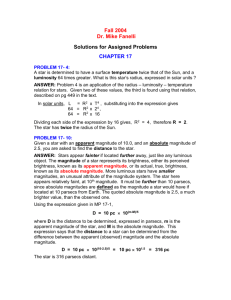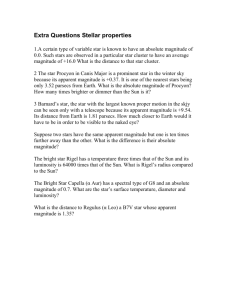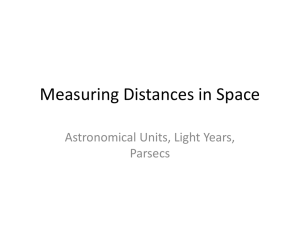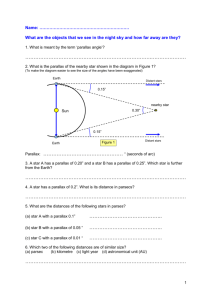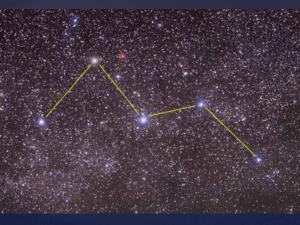Magnitudes
advertisement
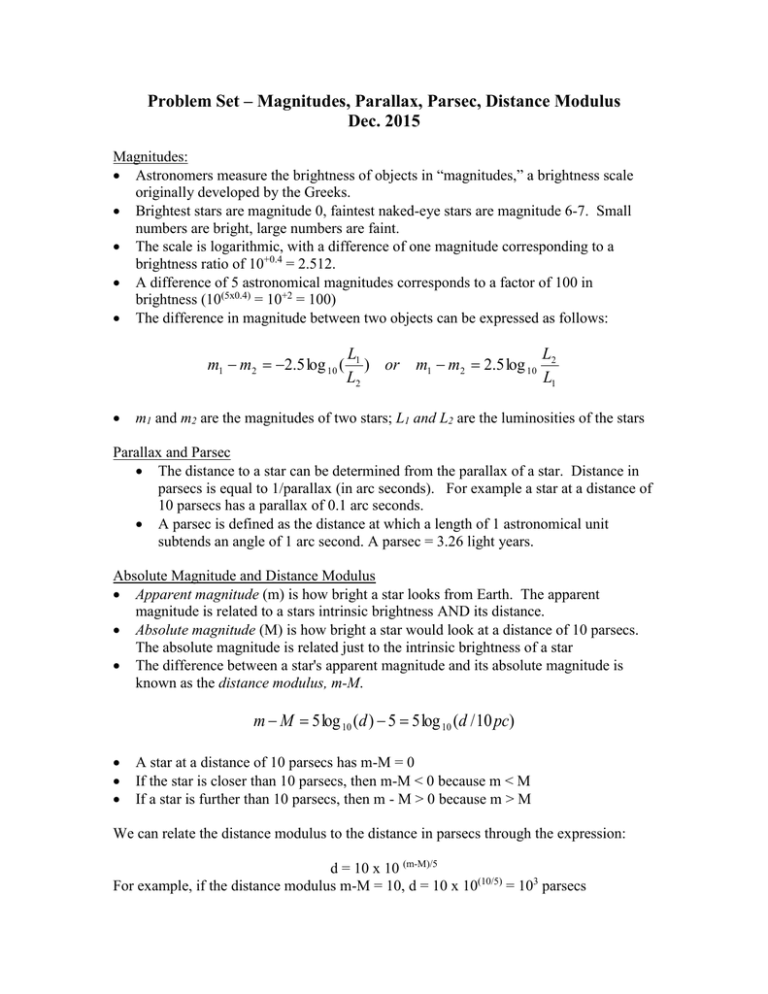
Problem Set – Magnitudes, Parallax, Parsec, Distance Modulus Dec. 2015 Magnitudes: Astronomers measure the brightness of objects in “magnitudes,” a brightness scale originally developed by the Greeks. Brightest stars are magnitude 0, faintest naked-eye stars are magnitude 6-7. Small numbers are bright, large numbers are faint. The scale is logarithmic, with a difference of one magnitude corresponding to a brightness ratio of 10+0.4 = 2.512. A difference of 5 astronomical magnitudes corresponds to a factor of 100 in brightness (10(5x0.4) = 10+2 = 100) The difference in magnitude between two objects can be expressed as follows: m1 m2 2.5 log 10 ( L1 L ) or m1 m2 2.5 log 10 2 L2 L1 m1 and m2 are the magnitudes of two stars; L1 and L2 are the luminosities of the stars Parallax and Parsec The distance to a star can be determined from the parallax of a star. Distance in parsecs is equal to 1/parallax (in arc seconds). For example a star at a distance of 10 parsecs has a parallax of 0.1 arc seconds. A parsec is defined as the distance at which a length of 1 astronomical unit subtends an angle of 1 arc second. A parsec = 3.26 light years. Absolute Magnitude and Distance Modulus Apparent magnitude (m) is how bright a star looks from Earth. The apparent magnitude is related to a stars intrinsic brightness AND its distance. Absolute magnitude (M) is how bright a star would look at a distance of 10 parsecs. The absolute magnitude is related just to the intrinsic brightness of a star The difference between a star's apparent magnitude and its absolute magnitude is known as the distance modulus, m-M. m M 5 log 10 (d ) 5 5 log 10 (d / 10 pc) A star at a distance of 10 parsecs has m-M = 0 If the star is closer than 10 parsecs, then m-M < 0 because m < M If a star is further than 10 parsecs, then m - M > 0 because m > M We can relate the distance modulus to the distance in parsecs through the expression: d = 10 x 10 (m-M)/5 For example, if the distance modulus m-M = 10, d = 10 x 10(10/5) = 103 parsecs 1. HAT-P-11b has a parallax of 0.0267 arc seconds. What is its distance from the Sun in parsecs and light years? The planet orbits its host star at a semi-major axis of 0.053 AU. What is the maximum angular separation of HAT-P-11 and HAT-P-11b? 2. 51 Pegasi has a parallax of 0.641 arc seconds. What is its distance from the Sun in parsecs and light years? The semi-major axis of 51 Peg b’s orbit is 0.053 AU. What is the maximum angular separation between 51 Peg and 51 Peg b? 3. WASP-43b orbits a KV7 star with a mass of 0.71 times the mass of the Sun. The visual magnitude (V magnitude) of WASP-43 is V=12.4. The absolute magnitude of a K7V star is 8.2. a. What is the distance modulus of WASP43-b? b. What is the distance to WASP-43 in parsecs and light years? c. What would you expect the parallax to WASP-43 to be? 4. The host star of WASP-18b is an F6 star with a mass of 1.25 solar masses. The parallax of WASP-18 is 0.01 arc seconds. a. What is the distance to WASP-18 b. What is the distance modulus of WASP-18? c. What is the absolute magnitude of WASP-18? 5. The parallax of HD 106906 is 0.011 arc seconds. a. What is the distance to HD 106906? b. The separation between HD 106906 and its putative planet, HD 106906 b is 650 AU.What is the angular separation on the sky between the star and the planet? 6. The parallax of 55 Cancri is 0.081 arc seconds. a. What is the distance to 55 Cnc? b. 55 Cnc is binary star consisting of a G8Vstar and a smaller, M3.5V red dwarf orbiting at a distance of 1065 AU. What is the maximum angular separation between the two stars? c. The apparent magnitudes of the two stars are 5.95 and 13.15. What is the relative luminosity of the two stars? d. What is the distance modulus to 55 Cnc? e. What are the absolute magnitudes of the two stars? 7. The apparent V magnitude of Kepler-186 is 15.65. Kepler-185 is an M1V star, and a typical M1V star has an absolute magnitude of 9.7. a. What is the distance modulus of Kepler-186? b. What is the distance to Kepler-186 in parsecs and light years? 8. The parallax of HR 8799 is 0.0254. a. How far away is it? (in parsecs and light years) b. What is the distance modulus to HR 8799? c. The V magnitude of the star is 5.95. d. What is the absolute magnitude of HR 8799


